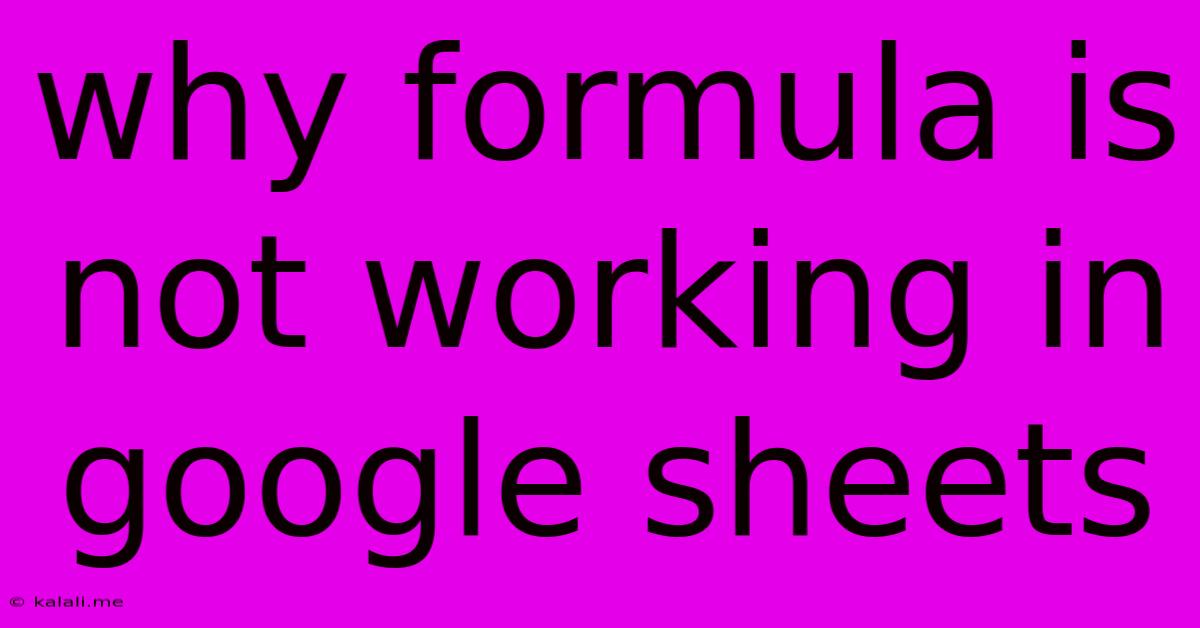Why Formula Is Not Working In Google Sheets
Kalali
Jun 01, 2025 · 4 min read

Table of Contents
Why Your Formulas Aren't Working in Google Sheets: Troubleshooting Common Issues
Google Sheets is a powerful tool, but even experienced users encounter formula errors. This comprehensive guide will help you troubleshoot common reasons why your formulas might be malfunctioning, ensuring you can get back to data analysis efficiently. This article covers error messages, common mistakes, and debugging techniques to get your spreadsheets functioning correctly.
Understanding Common Formula Errors
Before diving into specific problems, it's crucial to understand the common error messages Google Sheets displays:
- #ERROR!: This is a general error, indicating a problem with the formula's syntax or the data it's referencing. It often requires careful examination of the formula itself.
- #VALUE!: This error usually pops up when you're performing an operation on the wrong data type. For example, trying to add a number to text.
- #REF!: This indicates a reference error. You might be referencing a cell that doesn't exist, or a sheet that has been deleted.
- #N/A: This means "not available." The formula couldn't find the data it was looking for. This often occurs with
VLOOKUPorHLOOKUPfunctions when a value isn't found. - #DIV/0!: This occurs when you attempt to divide by zero. Double-check your formulas to ensure you're not dividing by a cell that contains zero or a blank cell.
- #NUM!: This error usually relates to numerical issues, such as invalid arguments in functions that require numerical input or performing calculations that result in an invalid numerical value (e.g., square root of a negative number).
Common Reasons for Formula Failure and Solutions
Let's explore some common reasons why your Google Sheets formulas might not be working as expected:
1. Incorrect Syntax and Case Sensitivity
Google Sheets is case-insensitive for cell references (A1 is the same as a1), but it is case-sensitive for function names. Ensure you use the correct capitalization for functions (e.g., SUM, AVERAGE, IF). A single misplaced parenthesis or comma can also cause errors. Carefully review your formula's syntax.
2. Circular References
A circular reference occurs when a formula directly or indirectly refers to its own cell. This creates an infinite loop and will typically result in an error. Google Sheets will usually alert you to this with a warning message.
3. Incorrect Cell Referencing
Double-check that your cell references are accurate. An incorrect row or column number will lead to incorrect results. Use absolute referencing ($A$1) when necessary to prevent references from changing when copying or moving the formula. Relative referencing (A1) adjusts the cell reference depending on where you copy the formula.
4. Data Type Mismatches
Formulas expect specific data types. Ensure numbers are formatted as numbers, dates are formatted as dates, and text is formatted as text. Mixing data types often leads to #VALUE! errors.
5. Hidden Rows and Columns
If you have hidden rows or columns referenced in your formula, the formula might not calculate correctly. Unhide them to ensure accurate results.
6. Incorrect Function Arguments
Many functions require specific arguments in a particular order. Refer to the Google Sheets help documentation for the correct syntax and argument order for each function. Incorrect arguments can lead to unexpected results or errors.
7. Spreadsheet Calculation Mode
Ensure your spreadsheet's calculation mode is set to "On." In rare cases, it might be set to "Iterative," or "Manual," which may require you to manually trigger the recalculation of formulas. This is usually found in the 'File' menu.
8. Formula Errors Related to External Data
If your formula relies on external data sources (e.g., Google Finance), ensure the source is accessible and provides data in a format the formula expects. Network issues or changes to the external data can cause issues.
Debugging Techniques
To effectively debug your formulas:
- Break down complex formulas: Simplify complex formulas into smaller, more manageable parts to isolate the source of the error.
- Use the
ISERRORfunction: This function can help identify cells containing errors. - Step through the formula: Use the Evaluate Formula tool (Data > Evaluate Formula) to step through the calculation process and identify the point at which an error occurs. This is a great way to pinpoint what is happening at each stage of the calculation.
By understanding these common issues and applying these troubleshooting techniques, you can significantly improve your efficiency in working with Google Sheets and effectively resolve formula errors. Remember to always double-check your formulas, data types, and references for accurate results.
Latest Posts
Latest Posts
-
How To Check When Database Went Offline In Sql Server
Jun 02, 2025
-
How To Say Mother In Japanese
Jun 02, 2025
-
How Many Angels Did God Create
Jun 02, 2025
-
How Do You Wire A Switch Outlet Combo
Jun 02, 2025
-
Creative Ways To Add Controls To Guitar
Jun 02, 2025
Related Post
Thank you for visiting our website which covers about Why Formula Is Not Working In Google Sheets . We hope the information provided has been useful to you. Feel free to contact us if you have any questions or need further assistance. See you next time and don't miss to bookmark.